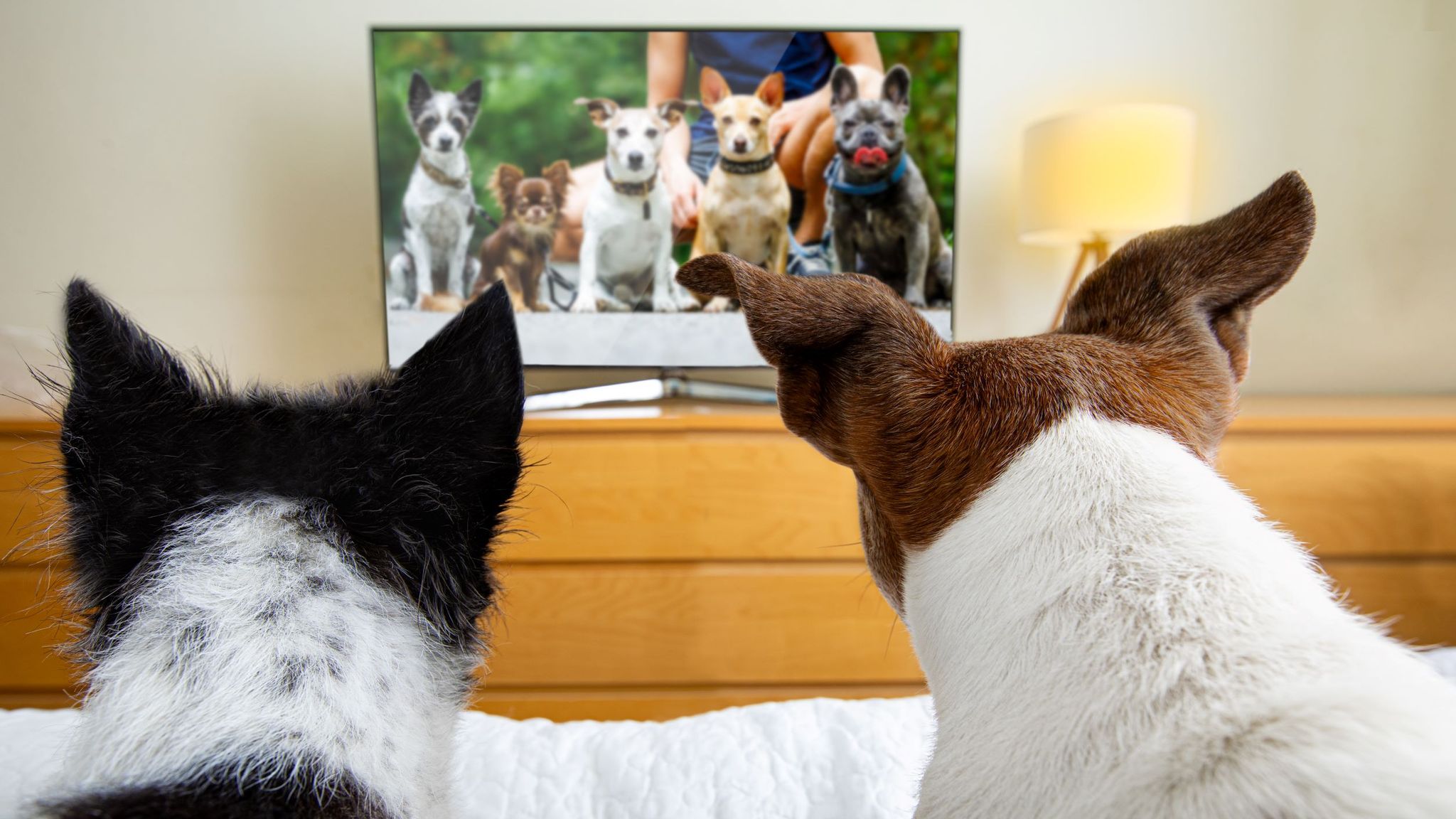Explaining the Concept of Dogs Watching TV
As technology continues to advance, it’s not uncommon to find our furry companions perched in front of the television, seemingly captivated by what’s playing on the screen. The concept of dogs watching TV may initially seem peculiar, but it has become a topic of interest and curiosity for many pet owners. Unlike humans, who can easily immerse themselves in television shows and movies, dogs’ visual perception and understanding of the content differ significantly.
The Growing Trend of Dogs Watching Television
Over the past few years, there has been a noticeable increase in the number of pet owners sharing videos and stories of their dogs reacting to TV programs. Whether it’s a dog chasing animals on nature documentaries or wagging their tail at the sight of other dogs on screen, these entertaining moments have sparked a trend of allowing dogs to watch TV. With an ever-growing range of pet-specific programming and channels, it’s evident that many pet owners are curious about the impact of television on their canine companions.
Purpose of the Article and Its Importance for Dog Owners
The purpose of this article is to delve into the topic of dogs watching TV, exploring the science behind their visual perception, the potential benefits and drawbacks of screen time, and providing practical tips for responsible TV-watching with dogs. It aims to address the curiosity and questions surrounding this phenomenon while offering guidance to dog owners on how to navigate TV entertainment for their pets safely.
Understanding whether dogs can watch TV and how it might affect their well-being is essential for pet owners who wish to provide enriching and stimulating experiences for their beloved companions. By shedding light on this growing trend, we aim to equip dog owners with the knowledge to make informed decisions about integrating television into their dogs’ lives and ensuring that any TV time is an enjoyable and positive experience for both pets and owners alike.
Can Dogs Watch TV? Understanding Dogs’ Visual Perception
How Dogs See the World – Differences from Human Vision
To understand if dogs can watch TV, it’s essential to recognize the differences between canine and human visual perception. Dogs have dichromatic vision, meaning they primarily perceive the world in shades of blue and yellow, lacking the ability to distinguish between reds and greens as humans do. Additionally, dogs have better night vision and motion detection, making them highly adept at tracking moving objects.
The Ability of Dogs to Perceive Images on TV Screens
While dogs can see images on TV screens, their visual experience differs from ours due to the differences in color perception and visual acuity. For dogs, the rapidly changing images on TV may appear as a series of flickering lights rather than coherent scenes. However, they can still detect movement and may be drawn to fast-paced visuals or sudden changes on the screen.
Factors Influencing a Dog’s Interest in Television
A dog’s interest in television can vary depending on several factors. Breed characteristics play a significant role, with certain breeds showing more interest in moving images due to their herding or hunting instincts. Additionally, a dog’s age, individual temperament, and previous exposure to TV may influence their level of engagement.
Some dogs may become captivated by the sights and sounds on TV, while others might show minimal interest or even indifference. The content displayed on the screen can also impact a dog’s response. Nature documentaries with animals or programs featuring other dogs might elicit more attention, whereas loud and startling sounds could lead to anxiety or avoidance.
As with any aspect of a dog’s life, it’s essential for owners to observe their pet’s reactions to TV and assess whether it enhances their well-being or causes distress. Understanding a dog’s visual perception and individual preferences can help tailor the TV-watching experience to ensure it is enjoyable and suitable for each unique canine companion.
The Pros and Cons of Dogs Watching TV
Potential Benefits of Dogs Watching TV
- Entertainment and Mental Stimulation: Watching TV can provide dogs with visual and auditory stimuli, especially when the content includes moving images or sounds of animals or other dogs. This can offer mental enrichment and prevent boredom, particularly for dogs that spend extended periods alone at home.
- Relaxation and Stress Relief: For some dogs, certain types of content, such as calming nature scenes or soothing music, can have a relaxing effect. Watching TV may help reduce stress and anxiety, promoting a sense of comfort and tranquility.
Possible Drawbacks and Risks of Dogs Watching TV
- Overstimulation and Hyperactivity: While TV can be a source of entertainment, some dogs may become overstimulated or overly excited by fast-paced and dynamic visuals on the screen. This heightened state of arousal might lead to hyperactivity or erratic behavior.
- Content and Its Impact on a Dog’s Behavior: The type of content a dog is exposed to can influence their behavior and emotional state. Aggressive or highly stimulating content might trigger anxiety or fear responses, potentially leading to behavioral issues or negative associations with TV time.
It’s crucial for dog owners to consider both the positive and negative aspects of dogs watching TV. While TV can provide mental stimulation and relaxation for some dogs, it might cause overstimulation or anxiety in others. The content selection plays a vital role in determining the impact of TV time on a dog’s behavior and overall well-being. Monitoring a dog’s reactions to TV and making thoughtful choices about the type of content can help ensure that TV-watching remains a positive and enjoyable experience for the canine companion. Additionally, balancing TV time with other forms of enrichment and exercise is essential for promoting a healthy and happy lifestyle for dogs.
Signs of a Dog Enjoying TV Time
Behavioral Cues Indicating Interest in the TV
- Rapt Attention: A dog enjoying TV time may display focused attention on the screen, often with ears perked up and eyes fixated on the images or movements.
- Tail Wagging: A wagging tail is a positive sign that the dog finds the content engaging or entertaining. It indicates excitement and interest in what they see on the screen.
- Playful Behavior: Some dogs might exhibit playfulness while watching TV, such as play bows, barking at moving objects, or attempting to “catch” images on the screen.
- Tilting Head: Dogs may tilt their heads while watching TV, a behavior that suggests curiosity and attentiveness to sounds or visuals.
How to Tell If the TV Is Stressing Out Your Dog
- Pacing and Restlessness: Restlessness or pacing in front of the TV might indicate that the content is causing anxiety or discomfort.
- Growling or Barking Aggressively: If a dog responds to specific images or sounds on the TV with growling or aggressive barking, it may be an indication of stress or perceived threats.
- Tail Tucked or Ears Back: These body language cues are typical signs of fear or anxiety, suggesting that the TV content is distressing for the dog.
- Hiding or Avoiding the TV: If a dog avoids looking at the TV or tries to hide when the screen is on, it could be a sign of discomfort or aversion to the visual stimuli.
Understanding Individual Preferences and Reactions
Just like humans, dogs have unique personalities and preferences. Some dogs may thoroughly enjoy TV time and find it entertaining and stimulating, while others might show little interest or even exhibit stress in response to screen content. Understanding each dog’s individual reactions is crucial to ensure that TV time is a positive experience.
Factors such as breed tendencies, past experiences with TV, and overall temperament can influence a dog’s response. For example, herding breeds might be more inclined to react to moving images, while some dogs might simply prefer other forms of entertainment or mental stimulation.
Dog owners should be attentive to their pets’ reactions while watching TV and adjust the content or duration of screen time accordingly. If a dog shows signs of stress or discomfort, it’s essential to provide alternative forms of enrichment and entertainment to promote their overall well-being.
In conclusion, dogs can indeed enjoy TV time, and their reactions can vary based on individual preferences and the content displayed on the screen. By observing a dog’s body language and understanding their unique responses, pet owners can tailor TV-watching experiences to suit their canine companions, providing enjoyable and enriching entertainment while ensuring their comfort and happiness.
Special Considerations for Puppies and Senior Dogs
How TV Exposure May Differ for Young Puppies
- Limited Attention Span: Puppies have shorter attention spans compared to adult dogs. They may not have the focus or patience to watch TV for extended periods. Short and engaging content may be more suitable for young puppies.
- Sensitive Developmental Stage: Puppies are still developing both physically and mentally. Excessive or overwhelming visual stimulation from TV might not be ideal during this sensitive phase of their growth.
- Content Selection: Puppies are like sponges, absorbing information from their surroundings. Careful consideration should be given to the type of content they are exposed to on TV. Programs with calm and positive visuals can be more beneficial for their early learning experiences.
- Avoiding Overstimulation: Overexposure to TV may lead to overstimulation, which can hinder a puppy’s ability to relax and rest properly. Monitoring their reactions and limiting TV time can help prevent this.
Adjusting TV Time for Senior Dogs with Sensory Changes
- Vision and Hearing Impairment: Senior dogs may experience age-related changes in vision and hearing. As a result, their ability to perceive images and sounds on TV could be diminished. Adjusting the screen’s brightness and volume levels may make TV time more enjoyable for them.
- Content Sensitivity: Older dogs might become more sensitive to certain types of content as they age. Loud or intense visuals might become distressing for them. Opting for calming nature scenes or milder programming can be more suitable for their comfort.
- Joint and Mobility Issues: Senior dogs may have limited mobility or struggle with joint stiffness. Ensuring that the TV screen is at an appropriate height and easily visible from their resting area can make TV time more accessible and enjoyable for them.
- Monitoring Stress Levels: As dogs age, they might become more susceptible to stress or anxiety. If a senior dog appears uneasy or agitated while watching TV, it’s essential to reduce exposure or choose content that promotes relaxation.
Understanding the specific needs of puppies and senior dogs during TV time is crucial for tailoring the experience to meet their developmental stages and age-related changes. Ensuring that the content is appropriate and that the screen time aligns with their comfort levels can provide both young and old dogs with positive and enriching TV-watching experiences. As with all aspects of a dog’s life, being attuned to their individual needs and preferences allows us to create an environment that supports their well-being and happiness.
Addressing Common Myths and Misconceptions
Watching TV Is Harmful to a Dog’s Eyes
Watching TV is not inherently harmful to a dog’s eyes. Dogs, like humans, are not at risk of eye damage from watching TV screens. While dogs have different visual abilities from humans, modern television screens do not emit harmful radiation or light intensity that could cause eye problems.
However, it’s essential to consider screen brightness and distance. Ensuring that the TV screen is not too bright and is at an appropriate viewing distance can reduce potential strain on a dog’s eyes, just as it does for human viewers.
Dogs Should Not Watch TV at All
Dogs can watch TV in moderation without any adverse effects, as long as it is done responsibly and thoughtfully. While not all dogs may show interest in TV, many can enjoy it as a form of entertainment and mental stimulation.
The key lies in understanding a dog’s individual preferences, reactions, and comfort levels. Some dogs may find TV time enjoyable and engaging, while others may not pay much attention to the screen. As long as a dog’s behavior remains relaxed and positive during TV time, occasional viewing can be a harmless and enjoyable experience.
Clarifying Misunderstandings About Dogs and TV
- Dogs Don’t See TV Like Humans: Dogs’ visual perception is different from ours, so they might not comprehend the content in the same way. They are more likely to react to moving images or sounds that mimic their natural instincts, such as animals or other dogs.
- TV Is Not a Substitute for Interaction: While TV can provide entertainment and mental stimulation, it should not replace regular interaction, exercise, and playtime with dogs. It’s crucial to balance screen time with other forms of enrichment and socialization.
- Individual Reactions Vary: Each dog will respond differently to TV content. Some may enjoy it and find it relaxing, while others may not show much interest. Understanding a dog’s preferences helps provide a positive experience.
- Content Selection Matters: The type of content shown on TV can influence a dog’s reaction. Calming nature scenes, animal documentaries, or pet-specific programs can be more enjoyable and suitable for dogs.
In conclusion, dogs can watch TV safely and enjoyably when it is approached with care and consideration. By dispelling common myths and understanding dogs’ individual needs and preferences, dog owners can provide enriching and positive TV-watching experiences for their canine companions. Responsible TV time, combined with regular exercise and interactive play, contributes to a well-rounded and happy lifestyle for our furry friends.
Consulting with Veterinarians and Experts
Seeking Professional Advice on TV Time for Your Dog
When it comes to incorporating TV time into your dog’s routine, consulting with a veterinarian or a qualified animal behaviorist can be beneficial. These professionals can offer valuable insights and guidance based on their expertise in canine health and behavior. Before introducing TV watching to your dog, consider the following:
- Discussing Your Dog’s Individual Needs: A veterinarian can assess your dog’s age, breed, health condition, and temperament to determine if TV time is suitable for them. Puppies, senior dogs, and dogs with specific health concerns may have different considerations.
- Addressing Behavioral Concerns: If your dog exhibits stress, anxiety, or aggressive behavior while watching TV, a behaviorist can help identify the triggers and provide strategies to address these issues.
- Content Selection: Veterinarians and behaviorists can advise on appropriate content choices that align with your dog’s preferences and well-being. They can recommend calming programs or pet-specific channels that promote relaxation and engagement.
How to Determine If TV Watching Is Suitable for Your Specific Dog
- Observe Your Dog’s Reactions: Pay attention to how your dog behaves during TV time. If they appear relaxed, engaged, or curious, it may indicate that TV watching is a positive experience for them. On the other hand, signs of stress, anxiety, or indifference might suggest that TV time is not the best fit.
- Moderation is Key: Even if your dog enjoys TV time, it should be balanced with other forms of mental and physical stimulation, such as playtime, walks, and interactive activities. Moderation helps prevent overreliance on screens and maintains a healthy balance in their daily routine.
- Create a Comfortable Environment: Ensure that the TV-watching area is a safe and inviting space for your dog. Provide soft bedding, toys, and water nearby, allowing them to enjoy TV time in a relaxed setting.
- Pay Attention to Content: Select content that matches your dog’s preferences and temperament. If your dog becomes overly excited or agitated by certain visuals or sounds, try opting for more calming or soothing programming.
- Respect Individual Differences: Every dog is unique, and what works for one may not suit another. Some dogs may thoroughly enjoy TV time, while others may show minimal interest. Respect your dog’s individual needs and adjust accordingly.
By seeking professional advice and observing your dog’s reactions, you can determine if TV watching is suitable for your specific dog. Remember that not all dogs will enjoy TV time, and that’s perfectly normal. The ultimate goal is to provide enriching experiences that contribute to your dog’s overall well-being and happiness. Whether it’s TV entertainment, interactive play, or outdoor adventures, tailoring activities to your dog’s preferences ensures a fulfilling and joyful life for your beloved companion.
Conclusion
Summarizing the Considerations for Dogs Watching TV
The question of whether dogs can watch TV has been explored, and it’s clear that dogs can indeed perceive images and sounds on screens. However, individual reactions to TV time may vary based on factors such as age, breed, temperament, and content preferences. Understanding dogs’ unique visual perception and considering their specific needs are vital when introducing TV time to our furry companions.
Encouraging Responsible TV Time and Monitoring a Dog’s Reactions
Responsible TV time for dogs involves selecting appropriate content that aligns with their interests and well-being. Moderation is key, as excessive screen time may lead to overstimulation or neglect of other essential activities. It’s crucial for dog owners to closely observe their pets’ reactions during TV time and adjust as needed to ensure a positive and enjoyable experience.
Emphasizing the Importance of Overall Mental and Physical Stimulation for Canine Well-Being
While TV watching can provide entertainment and mental stimulation for some dogs, it should not replace the need for regular interaction, physical exercise, and mental enrichment. Dogs thrive on social engagement, playtime, and exploring the world around them. Providing a well-rounded lifestyle that includes a variety of activities ensures their overall mental and physical well-being.
In conclusion, dogs can watch TV and enjoy it when approached with care and thoughtfulness. Understanding their visual perception and individual preferences helps create an enjoyable TV-watching experience. Responsible TV time, combined with regular exercise and mental stimulation, contributes to a balanced and fulfilling life for our beloved canine companions.
As responsible pet owners, we hold the power to enrich our dogs’ lives and strengthen the bond we share with them. By providing love, attention, and engaging activities, we can create a harmonious and joyful environment that nurtures our dogs’ happiness and supports their well-being. So, whether it’s a leisurely movie night or a day full of outdoor adventures, let’s cherish every moment with our furry friends and offer them the best life possible










